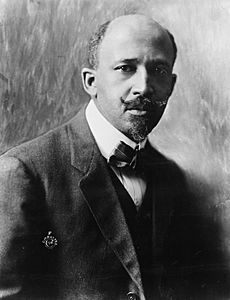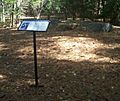W.E.B. Du Bois Boyhood Homesite facts for kids
Quick facts for kids |
|
|
W.E.B. Du Bois Boyhood Homesite
|
|

Memorial boulder, 2010
|
|
| Location | Great Barrington, Massachusetts |
|---|---|
| Area | 5 acres (2.0 ha) |
| NRHP reference No. | 76000947 |
| Added to NRHP | May 11, 1976 |
The W.E.B. Du Bois Boyhood Homesite in Great Barrington, Massachusetts, is a special place. It honors W.E.B. Du Bois (1868–1963), a very important African American thinker and civil rights leader.
This site holds the old stone foundation of his grandfather's house. Du Bois lived there for the first five years of his life. He later owned the house himself in 1928. He hoped to fix it up, but it was too difficult. He sold it in 1954, and the house was torn down soon after.
The homesite is on South Egremont Road. In the late 1960s, there were plans to make it a memorial. Some people in the town did not like this idea. They disagreed with Du Bois's strong political views later in his life. He moved to Ghana in 1961 and never came back to the U.S.
On May 11, 1976, the site became a National Historic Landmark. This means it is a place of great national importance. In 1987, the site was given to the state of Massachusetts. Today, the University of Massachusetts, Amherst helps take care of it.
Contents
Who Was W.E.B. Du Bois?
The Burghardt family, who were of Dutch background, lived near Great Barrington, Massachusetts a long time ago. They owned land there since the 1740s. Tom Burghardt was an African American slave in this family. He had Dutch, English, African, and Native American ancestors. He probably became free by fighting in the American Revolutionary War.
One of his descendants was Mary Silvinia Burghardt. She was the mother of William Edward Burghardt Du Bois, born in 1868. He is usually called W.E.B. Du Bois. He grew up to be a leading African American thinker and a civil rights activist. He also helped start the National Association for the Advancement of Colored People (NAACP) in 1909.
Du Bois's Childhood Home
By the early 1800s, the "Black Burghardts" lived in the Egremont Plain area. This was a few miles outside Great Barrington. Du Bois's father left the family. So, his mother moved with baby Du Bois to her parents' house.
In 1928, Du Bois wrote about this house. He called it "a delightful place." It was simple and square, with a big fireplace room. It had a kitchen with a stone floor, a step down from the main room. There was also a woodshed. Steep stairs led up to the bedrooms. Outside, there was a small stream, a well, and a huge elm tree.

When Du Bois was five, his grandfather passed away. His grandmother had to sell the house to pay off debts. Du Bois's mother then moved the family into Great Barrington. She worked hard to support her son.
Du Bois was a very smart student. He went to Fisk University with a scholarship. People from his church also helped pay for his studies. He earned another degree from Harvard. He also studied in Berlin. He was the first African American to get a doctorate degree from Harvard. He then began a very important career.
Later Life and the Homesite
Du Bois's birthplace was torn down around 1900. Over the years, Du Bois often came back to Great Barrington. His two children were born there. His son, Burghardt, died as a baby in 1899 and was buried in the local cemetery. Du Bois's wife, Nina, was also buried there after she passed away in 1950.
In 1906, after a difficult event in Atlanta, Du Bois sent his family to Great Barrington. He was working at Atlanta University at the time.
In 1925, Du Bois showed interest in buying his grandfather's property. Three years later, two brothers, Joel and Arthur Spingarn, bought the old Burghardt home. They were civil rights activists and involved with the NAACP. They gave the house to Du Bois for his sixtieth birthday.
Du Bois wanted to turn the property into a summer place for middle-class families. But he faced challenges and moved to Atlanta in 1934. This made it too hard to develop the property. In 1954, Du Bois sold the property to a neighbor. The house was old and falling apart, so the neighbor had it torn down.
Making the Site a Memorial

In 1967, Walter Wilson and Edmund W. Gordon bought parts of the old Burghardt land. This included the spot where the house used to be. They planned to create a park to honor Du Bois, who had died in Ghana in 1963.
Some local people did not like this plan. Wilson and Gordon were not from the area. People often criticized Du Bois for his support of Communist ideas. They also thought he had given up his American citizenship to live in Ghana. (He never gave up his U.S. citizenship, but he did accept Ghanaian citizenship.) He died and was buried in Ghana.
This was a time in the U.S. with big changes and disagreements, like the Vietnam War. Some groups, like veterans' organizations, did not like Du Bois's views. Wilson tried to explain Du Bois's important work for civil rights. He pointed out that other historical figures, like Benedict Arnold, were honored even though they had done controversial things.
Some people who supported the memorial thought the FBI might be causing the opposition. The FBI had watched Du Bois because of his views. However, the FBI decided not to get involved, as there was already enough local disagreement. Wilson felt that some opponents were against the memorial because of race. But no one said this directly. After the Civil Rights Movement passed new laws, like the Voting Rights Act of 1965, some people felt worried by the rise of the Black Power movement and city riots in 1967.
Wilson and Gordon created the Du Bois Memorial Foundation. This group took ownership of the land. Famous people like Ruby Dee, Ossie Davis, Sidney Poitier, and Norman Rockwell helped donate money. The foundation received the property in September 1969. They dedicated it to Du Bois later that year.
Some local people were still against it. A local newspaper even suggested the site should be damaged. The town briefly tried to stop the dedication ceremony. They said the memorial might not follow local zoning rules.
For the next ten years, the Foundation did not build much on the property. They were afraid that permanent signs or displays would be damaged or stolen. In 1976, ten years after Du Bois died, the site was named a National Historic Landmark. It was also added to the National Register of Historic Places.
In 1983, the University of Massachusetts, Amherst began digging at the site. They wanted to learn about the history of the "Black Burghardt" family. The university already had many of Du Bois's writings. In 1987, the Foundation gave the property to the state. The university became its caretaker. The university paid for a parking area and put up signs to explain the site.
Visiting the Homesite Today
Today, the 5-acre (2.0 ha) site has many pine trees. A path leads from the parking area to an information stand about Du Bois's life. Another path goes west to a small dip in the ground. Here, a large memorial stone with a special plaque was placed.
Near the southwest part of the property, you can still see the old stone foundation of the original house. People in Great Barrington now support Du Bois's legacy. They have marked other places in town that were important to him. Even so, the homesite has sometimes been damaged by vandals. The site is part of the Upper Housatonic Valley National Heritage Area.
If one slips out the northern neck of Manhattan and flies to the left of the silver Sound, one swoops in time onto the Golden River; and dodging its shining beauty, now right, now left, comes after a hundred miles of lake, hill and mountain, in the Old Bay State. Then at the foot of high Mt. Everett one takes a solemn decision; left is sweet, old Sheffield; but pass it by stolidly and slip gently into tiny South Egremont which always sleeps. Then wheel right again and come to Egremont Plain and the House of the Black Burghardts.
Images for kids
See also
 In Spanish: Sitio de la casa de la infancia de W. E. B. Du Bois para niños
In Spanish: Sitio de la casa de la infancia de W. E. B. Du Bois para niños





